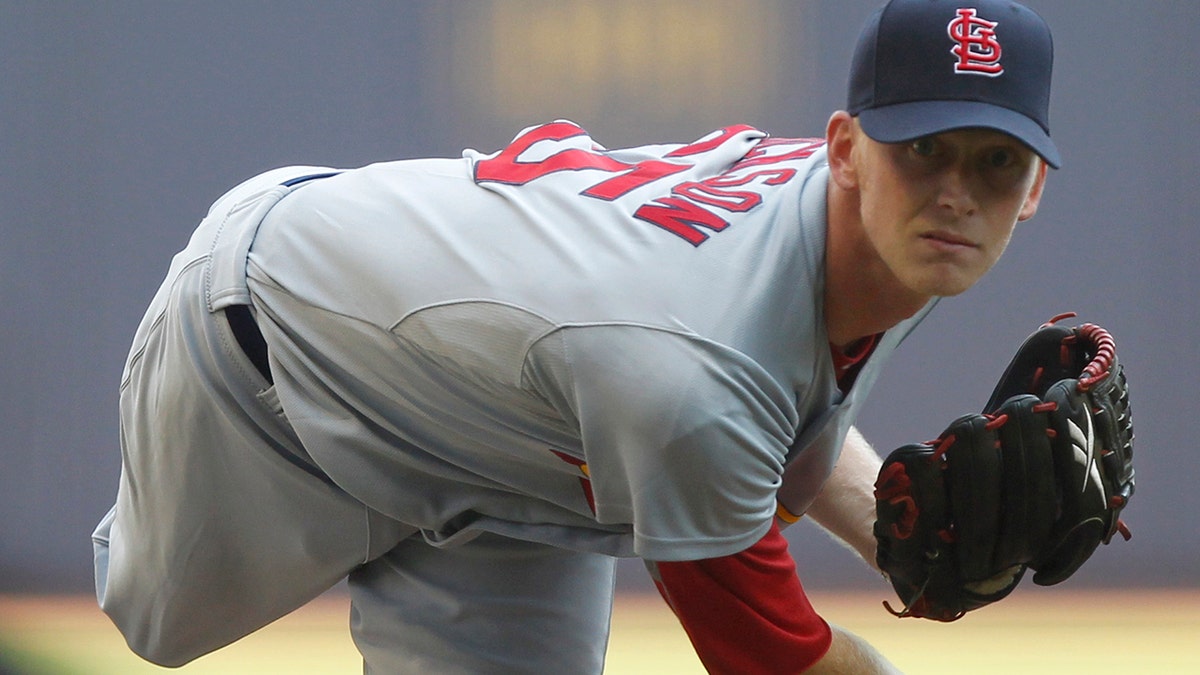
File-This Sept. 1, 2011, file photo shows St. Louis Cardinals pitcher Brandon Dickson throwing during the first inning of a baseball game against the Milwaukee Brewers, in Milwaukee. Dickson, the U.S. closer who blew a ninth-inning lead, threw his last major league pitch in 2012. (AP Photo/Jeffrey Phelps, File)
Brandon Dickson, the U.S. closer who blew a ninth-inning lead, threw his last major league pitch in 2012. Caleb Thielbar, who gave up the game-winning hit in the 10th, threw his last big league pitch in 2015.
The entire 28-man American roster at the Olympic qualifying tournament that ended Sunday combined for a career 2.1 Wins Above Replacement, according to Baseball-Reference — less than a quarter of Cody Bellinger's 9.0 WAR for the Los Angeles Dodgers this year alone.
Little wonder the U.S. failed to earn an Olympic berth at the Premier12 competition, where champion Japan and runner-up South Korea brought many top players.
Mexico qualified for the first time, rallying twice for a 3-2 victory over the U.S. in the bronze-medal game that determined an Americas berth. The U.S. will have two more chances to join host Japan, Mexico, South Korea and Italy in the six-nation Olympic field: an Americas tournament in the spring and, if it flops again, a final tournament that includes multiple regions.
"We cannot make major league players available for the actual tournament in August," Major League Baseball Commissioner Rob Manfred wrote in an email to The Associated Press. "In fairness to the other qualifiers and to protect the integrity of the competition, it seemed best to try and qualify with the level of players that will be available in August."
Just six U.S. players at the Premier12 had major league experience, none of them All-Stars: 39-year-old catcher Erik Kratz along with five pitchers: Dickson, Thielbar, Clayton Richard, Brian Flynn and Brooks Pounders.
While many players on the roster were high draft picks, just three first-rounders were among the 13 position players: Los Angeles Angels outfielder Jo Adell, Philadelphia third baseman Alec Bohm and Chicago White Sox first baseman Andrew Vaughn. And the only first-rounder on the pitching staff was Boston right-hander Tanner Houck. Just two players on the roster are among MLB.com’s top 100 prospects, Adell at No. 5 and Atlanta outfielder Drew Waters at No. 23.
American pitchers at the tournament had pitch limits — no starter threw more than five innings.
"I think that's just expected for good prospects pitching in November," said U.S. team general manager Eric Campbell, a veteran of three seasons with the New York Mets. "I think that's the expectation then it will be in March, as well."
MLB was a proponent of restoring baseball to the Olympics, believing it will spread the sport around the world
“Baseball is an international sport,” Philadelphia Phillies general manager Matt Klentak said. “As it becomes even more international, the presence of the United States in international tournaments is really important.”
Baseball was a medal event from 1992-2008. When the IOC voted in 2007 to drop the sport after the Beijing Games, British IOC member Craig Reedie cited “the lack of the MLB players.” The sport was restored three years ago for 2020 at the request of the Tokyo Organizing Committee, but in February the organizers of the 2024 Paris Games said they were recommending to the IOC that baseball again be dropped.
When baseball was last in the Olympics in 2008, only players not on 25-man rosters as of late June were eligible. For the Premier12, only players not on 40-man rosters could be picked — there are no 25-man rosters during the offseason.
"When I wear my general manager hat, my Astros hat, I don't want my players to risk injury. That's a very important consideration for us," Houston's Jeff Luhnow said. "Obviously, the players on our 40-man are players we've invested in, we've drafted, we've developed, we've signed, they clearly are risking injury every day that they go out during the regular season and spring training. But that's for us, it's not for another uniform."
Leagues in Japan and South Korea are interrupting their seasons for the Olympic baseball tournament, much as the NHL did for the men’s ice hockey competition from 1998 through 2014. Those decisions likely will make the Asian nations favorites.
And it remains to be seen whether MLB clubs will be even more reluctant to release players for the next qualifying tournament, which likely will take place during spring training, shortly after non 40-man roster players report ahead of minor league openers on April 9. Campbell said larger rosters would help if they are put in place.
“Then maybe you're back into a stacked-start-type scenario,” he said. “That may bring prospect X and prospect Y into the fold, if we're able to tag two guys to give you a quality start.”
